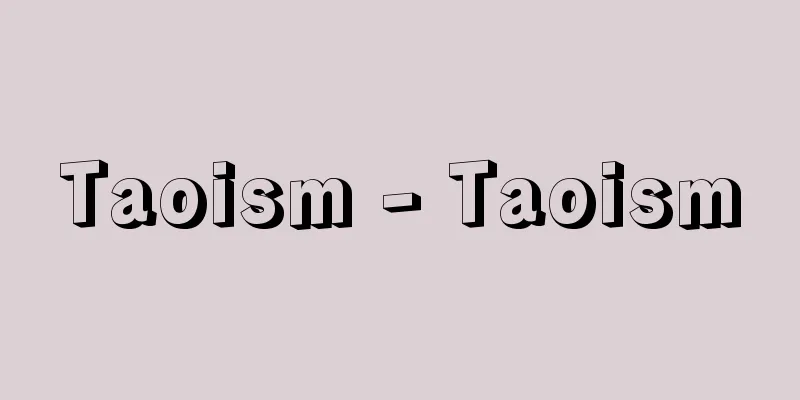Taoism - Taoism

|
Taoism is a representative Chinese national religion based on the life creed and religious faith of the unique lifestyle and culture of the Chinese people. It is based on the belief in shamanism, the belief in Taoist mystics, and the consciousness of the people before the Han dynasty, and was added with the belief in Huang Lao during the Han dynasty. It was formed roughly from the end of the Eastern Han dynasty to the Six Dynasties, and is still practiced today in Chinese societies such as Taiwan and Hong Kong. Early Taoist faith sought immortal immortals and placed emphasis on healing and warding off disasters through shamanism and Taoism, but it competed with and influenced Confucianism and Buddhism, and developed to also place emphasis on faith centered on inner self-cultivation and adherence to the moral consciousness of the people. [Tadao Sakai] Taoist ConceptTaoism is a cultural complex that includes all elements such as thought, doctrine, technology, society, religious organizations, objects of faith, and religious rites. It is based on the lifestyle culture that developed in relation to politics, society, and culture within the history, climate, and regional conditions of China. It can be said to be a religious culture unique to the Chinese people. Confucianism has a similar developmental pattern. However, the difference between the two is that Confucianism seeks to investigate Chinese society, national order, and academic technology from the perspective of the rulers, while Taoism focuses on religious elements and seeks to investigate social order and academic technology from the perspective of the people. Therefore, it also includes shamanistic beliefs in superstitions, demons, and strange ghosts that Confucianism rejected. This concept of Taoism can be broadly divided into two: "popular Taoism" and "church Taoism" (established Taoism). Popular Taoism refers to the faith and life creed of farmers and the general public, as well as the groups and associations organized based on them. This arose in the late Eastern Han dynasty, but developed in conjunction with Confucianism and Buddhism in response to the development of the common people's society, especially after the Song dynasty. On the other hand, church Taoism is a Taoist sect or denomination officially recognized by the state or dynasty, and the first was the "New Heavenly Master" of Kou Qianzhi in the 5th century. The Heavenly Master was originally called the "Five Pounds of Rice Master of the Three Zhangs (Zhang Ling, Zhang Heng, and Zhang Lu)," and was an early popular Taoism that arose mainly among farmers at the end of the Eastern Han dynasty, but the New Five Pounds of Rice Master, or New Heavenly Master, that developed under the Wei and Jin governments became church Taoism with the official recognition of the Northern Wei dynasty. [Tadao Sakai] Taoism, Taoism, Taoist, and Taoist termsThe original meaning of Taoism is "teachings that explain the way." The "way" is at the center of all Chinese thought and philosophy, including Confucianism and Taoism, and is, so to speak, at the root of Chinese consciousness. The word "Taoism" has been used since the pre-Qin period, and originally meant "the teachings of the way of the sages" and referred to Confucianism. After the introduction of Buddhism, there was a time when it also meant Buddhism. In other words, these words mean "teachings that explain the way of the former kings and sages," and do not refer to Taoism as the Chinese national religion as it is today. The methods and techniques to concretely realize this "teachings of the way of the sages" were called "Taoist arts." "Taoist arts" were originally "arts of the way of the sages," that is, political arts for governing the people. On the other hand, there were various "arts" such as "immortal arts" as a way to become a sage or to communicate with sages, "medical arts" as medical techniques, and other scientific techniques and sorcery. Those who practice Taoism are called Taoists, and those who practice Taoism are called Taoists. The difference between Taoism and Taoism is that the former is a state and political art of governing the nation and governing the people, while the latter has a personal and religious character. However, in the Later Han period, the two became confused. Thus, during the Later Han period, the scope of Taoism was greatly expanded to include not only political arts and scientific techniques, but also religious spiritual powers such as magic, prophecy, and divination. Moreover, those who practiced these were called Taoists, or "Taoists." In this case, "Taoists" are "Taoists" with religious elements, rather than the original "Taoists" who practiced Taoism in the Taoist Way of the Sages. "Tao" was a religious group that practiced Taoism under the leadership of Taoists, and this gave rise to "Taos," such as Kido, Shinto, Taiping-do, and Wudoumi-do. Religious groups that used the magic spells and talismans of shamans were called Kido. Taiping-do and Sanzhang Five Doumei-do were also early Taoist groups that made Kido an important element. The idiom "Shinto" was also created in reference to Kido. Kido was born from the "oni" in "kijin" (fiend), and Shinto was born from the "kami" (god). Shinto originally meant the road leading to the altar where gods are enshrined, but it gradually came to mean the gods themselves, the object of faith, or religious groups and teachings based on faith in gods. Taoism is one of the Hundred Schools of Thought, but during the Warring States period it had contact with Confucianism, Legalism, Mohism, Fangji, and Taoist immortals, and through the Qin and Western Han dynasties, religious elements were also mixed into the concept of Taoism in the Later Han dynasty. In other words, the concept of Taoism has come to have a broader meaning, including not only the philosophical Taoism centered on the ideas and philosophy of Laozi and Zhuangzi, but also "the art of Taoism" and "the art of Feng Shui." Thus, from the Late Han Dynasty to the Six Dynasties period, "Taoism" came to be used as an idiom that is similar to the word "Taoism" as a religion today. [Tadao Sakai] The origins of TaoismThe above-mentioned changes in the concepts of Taoism and Taoism are directly related to the history before the establishment of Taoism. During the Warring States period around the 3rd century BC, a religious group called "Fangxian Dao" existed in the Yan and Qi regions (Hebei and Shandong provinces) that focused on the art of Taoism. Originally, the state of Qi had mountain and river festivals for agricultural harvests performed by private shamans (sorcerers), and based on these, kings and nobles had mountain and river rituals in which the eight gods (Lord of Heaven, Lord of Earth, Lord of Yin, Lord of Sun, Lord of the Moon, Lord of the Sun, etc.) were worshiped and prayed for agricultural harvests. Fangxian Dao was formed by combining the worship of these eight gods with the studies of meridians (medical acupuncture and moxibustion) and materia medica (Chinese herbal medicine) that were already developed at the time, and the divine arts of walking, massage, feeding, and koya (exercises, food, and alchemical health care). Fangxian Dao was a religious group of Taoist priests. The kings and nobles of Qi and Yan, as well as the First Emperor of Qin, believed in the words of these priests and sent people to the three sacred mountains on the Bohai Bay, namely Horai, Fangzhang, and Yingzhou, where immortals were said to live, in order to obtain the elixir of immortality. They had the Taoist priests create elixir of immortality, especially gold, which they then consumed in order to attain immortality. Gold created by alchemy was considered the most effective elixir of immortality. One of the most famous Taoist priests sent to the Bohai Bay was Xu Fu (Jofuku), who, according to Japanese legend, washed up in Kumano, Kishu (Wakayama Prefecture), and other places. Furthermore, the First Emperor of Qin, based on the "Fengshan theory" preached by these Taoists, worshipped the gods of heaven and earth (Fengshan) at Mount Tai, the landlord of the eight gods, and its branch peak Liangfu, in an attempt to commune with the heavenly gods and attain immortality. During the Warring States period, Qi was at its height under the reigns of King Wei and King Xuan, and its capital, Linzi, attracted scholars from all over China, making it a major center of Chinese culture and scholarship (the study of the Ji sub-state). Among these, the Qi scholar Zou Yan advocated the theory of Yin-Yang and the five elements, and was known as the greatest scholar of his time. The Taoists skillfully used this theory of Yin-Yang and the five elements to incorporate it into the theory of immortals and the theory of Fengshan. In the northwestern inland area, the Kunlun Mountains immortal theory was formed based on mountain worship, and another theory related to this was born in the middle reaches of the Yangtze River. The rise of Fangxian Dao seems to be related to primitive maritime trade using the ocean currents of Yan and Qi, and the activities of Fangji disciples and speculators who sought medicinal herbs and gold in famous mountains, so it is better to consider the formation of the immortal theory on the Korean Peninsula and the legend of Xu Fu's arrival in Japan during the Yayoi period in the context of such events. The Yellow Emperor, who is said to be the creator of China in mythology, was associated with Taoism and medicine since the Warring States period and was considered the ancestor of immortals. Many of the books on the arts (medicine, immortals, etc.) in the "Arts and Lies" section of the "Book of Han," which records the learning of the Han dynasty, are named after the Yellow Emperor. The Yellow Emperor, who became an immortal, combined with Laozi, a Taoist, to create the "Words of Huang Lao." From the end of the Warring States period to the Qin and early Han dynasties, politics was carried out in unison between "Taoism" and "Legalism," but from the Taoist point of view, politics was based on the "Words of Huang Lao" and the "Arts of Huang Lao." As Laozi became an immortal with the Yellow Emperor and "Huang Lao" became an immortal object, in the later Han dynasty, the theory of divination, which had already arisen at the end of the Western Han dynasty based on the prophetic book "Hetu Luoshu," influenced the formation of Taoist thought. The theory of divination supplements the Confucian theory of the Classics with other theories such as the theory of Yin-Yang and the five elements, and numerology, and is primarily a prediction of social and political events. This theory of divination and the influence of Buddhism led to the formation of the religious group Huang Lao Dao. As a result of the mutual influence between Buddhism and Chinese culture, Huang Lao was considered to be the same as Futo (an old Chinese translation of Buddha), Laozi was deified, and Taishang Laojun (Taishang Laojun) was established as an object of faith. From the middle to the end of the Eastern Han Dynasty, the religious associations of farmers and common people, Taiping Dao and Wudoumi Dao, were formed from Huang Lao Dao and Wudoumi Dao (Gi Dao), which mainly focused on magic. Both Taiping Dao and Wudoumi Dao were early Taoist sects, and Wudoumi Dao in particular was later called Tianshi Dao and formed a major sect of Taoism. Therefore, in terms of the history of Taoism, the period up to the establishment of the Taiping Dao and the Five Pecks of Rice Dao can be considered the pre-history of Taoism (primitive Taoism) and can be distinguished from the history of Taoism that followed. [Tadao Sakai] The Establishment of Various Taoist SchoolsThe Taiping Dao originated in the mid-Later Han Dynasty when Gan Ji (or Yu Ji) was given the Taiping Sutra (Taipei Jing) by Taishang Laojun. Zhang Jue of Hebei organized the Taiping Dao, using this scripture as the basis of his religious movement. However, Zhang Jue later rebelled, which led to the annihilation of the Taiping Dao, and the remaining Taiping Dao members merged with the Wudoumi Dao, a religious group that Zhang Ling started in the Chengdu area of Sichuan. The Wudoumi Dao was a religious group founded by Zhang Ling in the Chengdu region of Sichuan. The group was based around Taoist ideology, and performed magical healing treatments, for which the members were required to pay five dou of rice (about five sho in Japan) as a reward, hence the name. It was believed that the sick person would be taken to a quiet room to reflect on their past sins, and that they would be cured if they offered three copies of a letter in which they wrote their name and past sins to the three gods of heaven, earth, and water, namely the Heavenly Official, the Earthly Official, and the Water Official, and provided offerings and labor for atonement. This idea that illness was caused by past sins also existed in the Taiping Dao. It was not until the time of Zhang Ling's son Zhang Heng and grandson Zhang Lu that the Five Pours of Rice Dao established itself as a religious sect. In particular, during the time of Zhang Lu, the sect flourished under the protection of the governor of Yi Province, but later, under pressure, it moved from eastern Sichuan to Hanzhong in Shaanxi, and then submitted to Cao Cao and became his vassal, expanding its influence among the powerful families, aristocrats, and peasants east of Tong Pass (Kanto). The Kanto Five Dou Rice Tao changed from a cult centered on primitive magic to one that linked with powerful families and aristocrats and focused on Taoism and other Taoist arts. This lineage of Five Dou Rice Tao spread to Jiangnan (south of the Yangtze River), giving rise to the aristocratic Five Dou Rice Tao beliefs seen in the family of the famous calligrapher Wang Xizhi of the Jin Dynasty, and the peasant and popular religious rebellions led by Sun En and Lu Xun at the end of the Eastern Jin Dynasty. Meanwhile, the Five Dou Rice Tao that spread to North China competed with Buddhism and incorporated Confucian order, developing into Kou Qianzhi's "New Heavenly Master Tao." This New Heavenly Master Tao was made the state religion by Emperor Taiwu of the Northern Wei Dynasty, and the so-called Church Taoism was established here. Also, from the end of the Later Han to the Six Dynasties, a Taoist religion was born based on the powerful families of Jiangsu and Jiangnan, combining the ideas of the Zhuzi and Huang Lao with various Taoist techniques and divination ideas, and Zuo Ci, Ge Xuan, Ge Hong and others appeared. This lineage of Taoist religion was compiled by the Taoist Zuo Ci, who fled to Jiangnan to escape the wars at the end of the Han, and inherited by the Ge Xuan clan who received his teachings. It is also called the Ge Way. Ge Hong, whose great-grandfather was Ge Xuan, wrote the Baopuzi and compiled the Taoist and Immortal Mantras based on alchemy that were passed down in this lineage. After Ge Hong, the Ge clan created the basic parts of the later Lingbao Jing. This scripture was later inherited as the scriptures of this lineage of Taoism. Around the same time, in Maoshan, Jiangsu, the Taoist Yang Xi is said to have had a penchant for a scripture called the Shangqing Classic in 364. Lu Xiujing of the Liu Song dynasty, said to be a descendant of the prime minister of Wu, was originally a Taoist of the Tianshi Dao lineage, but he obtained the Shangqing Classic while traveling around the country and organized it. He was also familiar with the Ge Dao, and organized the early Lingbao Jing, establishing the "Three Caves Theory," a classification system for the Daotang, which later became the culmination of Taoist scriptures. Tao Hongjing took over from Lu Xiujing's organization of scriptures, and based in Maoshan, he perfected the Shangqing Classic and established the so-called "Shangqing school." His philosophy was based on the scientific study of medicine, meridians, and Taoism, and also had some influence from Buddhism. It can be said that he was the first to establish a theoretical Taoist doctrine. From the end of the Six Dynasties to the Sui Dynasty, Xintianshidao was established in northern China, while Tianshidao and Shangqing schools were established in the Jiangnan region. In the Tang Dynasty, a movement aimed at integrating and exchanging between northern and southern Taoism became active, centered around Maoshan, the home base of the Shangqing school. Wang Yuanzhi, a Shangqing school Taoist priest from the early Tang Dynasty who was taught by Tao Hongjing, initially trained in Xintianshidao, and his disciple Pan Shizheng moved from Maoshan to Songshan, the home base of Xintianshidao. The success of the Shangqing school made Maoshan the central presence of Taoism in the Tang Dynasty, and the Shangqing school developed into one of the two major schools of Taoism, alongside Tianshidao. [Tadao Sakai] Interaction between Taoism and BuddhismEmperor Taiwu of the Northern Wei Dynasty (reigned 423-452) made Kou Qianzhi's Shin Tianshi Dao the state religion at the urging of his prime minister Cui Hao, and named the era Taiping True Prince (440). Cui Hao, a powerful Han Chinese who believed in Taoism, sought to eliminate Buddhism, which he considered to be the teachings of barbarians and a source of damage to the dynasty's finances, and urged Emperor Taiwu to suppress Buddhism in 446 (the first of the Three Wushu and One Sect Persecutions). Buddhism was revived after Emperor Taiwu, but was suppressed again during the reign of Emperor Wu of the Northern Zhou Dynasty (reigned 560-578). Emperor Wu of the Northern Zhou Dynasty promoted a policy of adapting both Buddhism and Taoism to the Confucian dynasty system. In 569, Confucian, Buddhist, and Taoist debaters were gathered three times to debate, but no decision was reached. Instead, the Buddhist side created the "Shodo-ron" and "Eikyo-ron" to attack Taoism. In the debate of 572, Emperor Wu ranked the three religions as Confucian, Taoist, and Buddhist, but in the debate between Taoism and Buddhism in 574, the Taoist priest Zhang Bin was defeated by the Buddhist side. In the end, he abolished both Buddhism and Taoism, and forced monks and Taoists to return to secular life (the second persecution). He then renamed "Xuantu Temple" to "Tongdao Temple" and established a national religious research institute, where outstanding teachers of the three religions were appointed as Tongdao Temple scholars and had them research the Confucianization of Buddhism and Taoism. From the Six Dynasties to the early Tang Dynasty, there appeared Taoists who excelled in mathematics and divination and became political advisors to the dynasty, received special treatment, and were appointed as Grand Historians. These included Tao Hongjing of the Southern Liang Dynasty, his disciple Wang Yuanzhi, and Fu Yi of the early Tang Dynasty. Emperor Wen of the Sui Dynasty valued Buddhism, but he combined the Tongdao Temple, which Emperor Wu of the Northern Zhou Dynasty had established in the capital Chang'an, with the Xuantu Temple, and placed the Xuantu Temple alongside the Buddhist Daxingshan Temple. The next emperor, Emperor Yang, believed in the theory of immortals and valued Taoists who excelled in Taoism, but he did not approach Wang Yuanzhi. Even before ascending to the throne, the Tang Dynasty's first emperor, Li Yuan, and his second emperor, Li Shimin, received a message from Wang Yuanzhi about the Grand Master of the Tang Dynasty, and began the work of founding the Tang Dynasty. The Grand Master's surname was the same as that of the Tang Dynasty, so Laozi was considered to be the ancestor of the Tang Dynasty. Wang Yuanzhi, who predicted the Tang Dynasty's mandate, was given a special rank and given the purple robe, and was appointed Taoist Fuyi as the Grand Historian. During the reign of Taizong, the order of monks and Taoists in the court was Taoist before Buddhism, but Empress Wu Zetian valued Buddhism and reversed the order. Xuanzong was devoted to Taoism and received the Fa Luo himself, and made Grand Master Xuanyuan Emperor Grand Master Xuanyuan Emperor and built Xuanyuan Emperor mausoleums in various places. He also established the Dao Ceremony system, similar to the imperial examination system, and opened the way for Taoists to be appointed to government positions. He established the "Chongyuan School" in the Xuanyuan Emperor's temple and "Taoist Schools" in each province, where students studied Laozi, Zhuangzi, Liezi, and others. Examinations on the results were conducted following the model of the Ming Classics department. In addition to Wang Yuanzhi and Fu Yi, the Taoists of the early Tang period included Sun Simiao, who excelled in the study of formulae and wrote "Thousand Golden Formulas" (collected in the Daozang). During the reign of Emperor Gaozong, Wang Yuanzhi's disciple Pan Shizheng and Ye Fashan, who excelled in the arts of talismanic magic, divination, and health care, were highly valued. Ye in particular was a trusted aide to the emperor from Gaozong to Zhongzong. Sima Chengzhen of the Shangqing faction was highly trusted by Xuanzong and bestowed upon him the Falu. Wuzong summoned 81 Taoist priests, including Zhao Guizhen, to the palace to perform a ritual, and received the Dharma scepter at the Altar of Nine Heavens in the palace, becoming a Taoist emperor. Following Zhao's advice, he suppressed Buddhism in 845 (the third persecution of the Huichang period). Emperor Shizong of the Later Zhou Dynasty of the Five Dynasties era then abolished Buddhism in 955 (the fourth persecution). In this abolition, he severely purged corrupt Buddhist sects in order to restore national finances, but the damage to Taoism was minimal. At this time, many monks and nuns who had been ordained privately were allowed to return to secular life and become "commoners". Both monks and Taoists were issued official documents, known as docho, to prove their ordination. The system of docho seems to have begun in the Six Dynasties period, but it was not until the Tang dynasty that it became a system. The system of certificates for monks and nuns is often explained, and it can be said that Taoists and female capped priests were treated similarly to monks and nuns. In principle, a trial test was required to issue a certificate, but this led to problems such as false monks and Taoists who did not have an officially approved certificate and those who sold certificates. This seems to have been more prevalent among monks and nuns than among Taoists. During the Five Dynasties period, Taoism developed in the countries of Jiangnan. The Taoist Du Guangting of the late Tang Dynasty belonged to the Maoshan school in Jiangnan and the Tianshi Daoist school of Longhu Mountain (Jiangxi Province). He entered Sichuan and was highly esteemed by Wang Jian and Wang Yan of Former Shu, where he organized the Taoist scriptures and compiled the ceremonies. Later Shu, Wu, and the Southern Tang that succeeded Wu all protected Taoism within their territories. It was during the reign of Wu and Southern Tang that Zhang Tianshi Dao of Longhu Mountain was given a manor and solidified the foundation of a religious organization. The state of Wu and Yue highly esteemed Luqiu Fangyuan, a master of the Maoshan school. During the Song Dynasty, under the rule of Emperor Zhenzong (reigned 998-1022), who was defeated in the war with the Liao Dynasty and concluded the Alliance of Chanyuan (1004), Taoists, mainly from the Maoshan sect, combined Confucian belief in heaven with Taoist techniques of summoning spirits, causing the "Tianshu Incident" in 1008. The Tianshu proclaimed that the Song Dynasty would continue for a long time if it adopted Taoist government. Furthermore, in 1012, the Song Dynasty's founding god descended to earth. Zhenzong strengthened his policy of respecting Taoism, and in 1015 summoned the 24th Tianshi of the Longhushan Tianshi Dao, Zhang Zhengzui, to solidify the relationship between the dynasty and the Tianshi Dao. From this time onwards, a system was created in which Taoist temples (Taoist temples) were managed by high-ranking officials. The True School, under the leadership of its Prime Minister Wang Qinruo (962-1025), mobilized Taoist priests to edit the Daoist Canon, which compiled the "Homon Tong Lu". In 1013, the Daoist Canon, "The Great Song Tian Gong Treasure House", was completed, with the assistance of the Taoist Zhang Junfang and others. Zhang Junfang took the essence of the canon and wrote "The Cloud and the Seven Lottery Decks". In the face of national crisis, the Song dynasty not only implemented Wang Anshi's "new method", but also sought to borrow the power of Taoism. Huizong placed great value on the Taoist Lin Lingsu, who practiced the Taoist technique known as the "Five Thunder Method". He also wrote his own commentaries on the "Laozi" and "Zhuangzi". After the Southern Song dynasty, the use of religion for political and military purposes weakened, and the monarchy's control of Buddhism and Taoism, as well as the policy of turning monks and Taoists into "citizens," strengthened. The government offices that managed monks and Taoists who had received ordination certificates gradually consolidated after the mid-Tang dynasty, and in the Song dynasty, the system of the "Sengokusi" and "Dorokusi" was established, and the "Dorokusi" (Taoist officials) belonging to this Daorokusi managed all Taoist priests and female caps, with outstanding Taoist priests being appointed as Daoist officials. The registries of monks and Taoist priests were kept in the same way as the "citizens," and from 1145, exemptions from taxes were collected from monks and Taoist priests in line with the taxes of the "citizens." The introduction of Buddhism to China not only created conflict and fusion between Confucianism and Taoism within Chinese culture, but also caused intense cultural friction between Confucianism/Taoism and Buddhism. As a result, the relationship of the three religions, Confucianism, Taoism and Buddhism (at the end of the Six Dynasties), was born due to competition between the three schools and the Confucianization of Buddhism. During this time, the practice of Confucianism, Taoism and Buddhist priests practicing the three religions simultaneously became widespread. [Tadao Sakai] The development of popular Taoism and neo-TaoismDue to the Tang Dynasty's policy of promoting Taoism, the area of church Taoism spread steadily throughout China. Since the end of the Tang Dynasty, Taoism spread to various regions and combined with local customs, developing into a folk belief (popular Taoism) that unified the three religions. Thus, in the Song Dynasty, a new popular Taoism that unified the three religions developed against the backdrop of the development of common people's society. The characteristic of popular Taoism in the Song Dynasty was that it took the form of a unification and fusion of the three religions of Confucianism, Buddhism, and Taoism, and there was a strong tendency to practice virtue (morality) that was applicable to both the nobility and common people, and to encourage others to do the same, deepening the popular Taoist faith in everyday life and culture. In popular Taoism, the Gonggua Ge (Gong Guo Ge), which preached popular moral practice with a strong sense of subjectivity among the people (described below), was created, and new Taoist religious organizations were born that were closely connected to popular society. This was probably due to the development of popular society and the revitalization of popular society stimulated by the rule and oppression of the "Jin" country from the north. Taoist sects that were formed on the basis of popular Taoism are called "New Taoism." The earliest New Taoism to be established was the "Tayi Sect" by Xiao Baozhen of Henan. This sect forbade strong food, alcohol, and marriage, placed great importance on everyday ethics, and focused on treating illness and warding off disasters through talismans and prayers. Next, Liu Deren of Shandong founded the "True Great Taoism." The teachings of this sect forbade strong food, alcohol, and adultery through prayer to heaven, and preached the adherence to everyday ethics such as loyalty and filial piety. Furthermore, the Quanzhen Sect, which later became the most influential Taoist sect, was founded by Wang Chongyang (Wang Yan), and basically took the position that Confucianism, Buddhism, and Taoism were of the same origin. It read such scriptures as the Heart Sutra, the Book of Filial Piety, the Tao Dao Jing, and the Sutra of Purification as its scriptures, rejected the art of talismans, and did not rely on the theory of immortality, but instead preached both internal and external training (the practice of "true merit" and "true action" for the benefit of oneself and others). Furthermore, as the moral consciousness of the common people increased, the practice of everyday ethics became religious, and so did the "Good Books." These are books that encourage good deeds, and are popular moral books that preach ethics for the common people's daily lives based on the foundations of common morality and on Taoist beliefs and Buddhist thought. It was around this time, that is, at the beginning of the Southern Song Dynasty, that the representative "Good Books" "Taishang Gan'ying Pian" was written by lower-class readers in Jiangnan. On the other hand, faith in Xu Zhenjun, who was skilled in the Taoist arts of mathematics and divination, had been practiced in the middle reaches of the Yangtze River since the Six Dynasties period, but when the "Song" dynasty fought against the "Jin" dynasty, the "Law of Loyalty and Filial Piety" was added to this faith, and a religious group called the "Jingming Dao of Loyalty and Filial Piety" was born, and this "Jingming Dao" was established by Liu Yuzhen in the Yuan dynasty. It is said that the "Gong Guo Ge of the Great Immortal Lord" was written by this sect in the late 12th century under the rule of Jin. In "Gong Guo Ge," daily actions are divided into merits (good deeds) and deficiencies (bad deeds), each is given a score, and the more merits and deficiencies you have, the more blessings you will receive. The Quanzhen Sect expanded its influence throughout northern China through the Taoist priest Qiu Chuji (Changchun Zhenren), who was trusted by the Yuan dynasty. Changchun Zhenren's Quanzhen sect was called the Longmen sect. Baiyun Temple in Beijing was the representative Taoist temple of the Quanzhen Sect and was a Ten Directions Monastery (a training center for Taoist priests of each school). The Tao of Evil, centered on Huangye Jindan (Kouya Jindan), a Tao of immortals based on Taoist techniques, is thought to have existed since ancient times, but in the mid-Northern Song Dynasty, Zhang Boduan (Zhang Ziyang) appeared and wrote the "Wuzhen Pian" to raise the name of the Taoist Tao, and took advantage of the fame of the Quanzhen Sect to call himself the Southern Quanzhen Sect and the Wang Yan Sect the Northern Quanzhen Sect. In the early Ming Dynasty, the name of Zhang Sanfeng (Zhang Sanfeng) as an immortal was widely spread among the Taoist Taoists, and his influence extended to the Taoist Taoists of the late Ming Dynasty. Also, from the early Ming Dynasty, Zhang Sanfeng was said to be an immortal Taoist associated with the Taoist sect (Wudang Dao) that believed in Xuantian Shangdi (Zhen Wu) and was based in Wudang Mountain (Taihe Mountain) in Hubei Province. In addition, during the Qing Dynasty, Liu Yimin emerged from the Jindan Dao and further developed its theory. After the Song Dynasty, the New Taoist sects were more strongly controlled by the dynasty, along with former Taoist sects such as the Shoichi Church of Longhu Mountain (the Tianshi Do was called Shoichi Church from the Yuan Dynasty), and after the Ming Dynasty. The Yuan Seoso gave the right to control Taoism in Jiangnan to the Shoichi Church, and the Taoism in North China to the Zenshin Church. He also gave the right to issue Do-San and the right to appoint local Taoist. During the Ming Dynasty, Do-Lunji was placed in the Liberation Club, and managed by the Seichi and Zenshin Church. Furthermore, Taoist sects below Shoichi Shrine were placed in the Yuan Dynasty, and Taoist sect was placed in the Midori and Taihe Mountain. Taoist sects of the Ming Dynasty were not given a salary garner, and in effect became the position of the cult management.になったんです。 English: The first thing you can do is to find the best one to do. [Tadao Sakai] The current state of Taoismになったんです。 English: The first thing you can do Taoist faith remains in Hong Kong, including the Zenshinkyo Qing Song Kang, as well as the Taoist temple and temples are flourishing. The headquarters of the Taoist association, the Red Swastika, is currently located here. Taoist faith is also popular among Chinese communities in Southeast Asia and overseas overseas Chinese. In the Chinatown of San Francisco, the United States, there is a branch of Qing Song Kang in Hong Kong, and in Yokohama and Kobe, there is a temple and the worship of Chinese residents in Japan. [Tadao Sakai] Propagation of Taoismになったんです。 English: The first thing you can do is to find the best one to do.になったんです。 English: The first thing you can do is to find the best one to do. [Tadao Sakai] Taoist scripturesOriginally, Taoist sutras were the Taiping Sutra of the Taiping Path in the Lao Han Dynasty, the Laozi of the Woodo Mei Path, and the Supercance Sutra and Reibao Sutra from the early Six Dynasty, but apart from these, there were many different types of sutras, such as sutras that were passed down from gods who were introduced to each sect and association, as well as stoves and divine figures. In Ge Hong's "Ba-Pokzi" there is a catalog of sutras from the early 4th century, and the names of early sutras have been revealed. It was Lu Xizi who created a classification standard for these diverse Taoist sutras, and according to the three dot theory, the Supercance Sutra was divided into the "Donghen Club," the "Donghen Club," and the "Donghen Club." In the first half of the 6th century, the idea of "Shiho" was established, and various parts of the sutras that assisted Dou Gen, "Taigenbu" as "Taigenbu" as "Taigenbu" as "Taigenbu" as "Taisenbu" as "Taisenbu" as "Taisenbu" as "Taisenbu" as "Taisenbu" as "Taisenbu" as "Taisenbu" as "Taisenbu" as "Taisenbu" as "Taisenbu" as "Taisenbu" as "Taisenbu" as "Taisenbu" as "Taisenbu" as "Taisenbu" as "Taisenbu" as "Taisenbu" as "Taisenbu", "Taisenbu" as "Taisenbu" as "Taisenbu" as "Taisenbu", "Taisenbu" as "Taisenbu" as "Tianshido", and "Taisenbu" as "Tianshido" as "Tianshido". Some Taoist sutras have been adapted from Buddhist sutras, and in opposition to Buddhism, many sutras such as rituals and precepts were also compiled. Some of the scriptures of the popular Taoism are contained in Dozo, but many good books and treasure books can be mentioned. The appearance of the book began in the Song Dynasty, but at the end of the Ming Dynasty, the Confucianist Yuan Huang (Ryong Bon) and Buddhist Buddhist Shukong were active in the movement to make good books, and many good books were produced in the late Ming Dynasty. These include a variety of "Gong Excess," "Inshizubun," and "Guan Jitsuji." In addition to the "Guan Jitsuji," there are also the "Guan Jitsuji," which appeared in the middle of the Qing Dynasty. The production of the book continued in Taiwan, Hong Kong, Southeast Asia, and other places until the present day of the Qing Dynasty. The book includes both common literature and scriptures related to religious associations. Among the latter are five copies of the Immortal Church (La) religion), but many of them are written in a book called Hajashoben in the end of the Qing Dynasty. [Tadao Sakai] "Koyanagi Jikita, "Thought of Laozhou and Taoism" (1942, Sekishoin)" ▽ "Fukui Yasujun, "Fundamental Research on Taoism" (1952, Eirasha)" ▽ "Sakai Tadao, "Study of the Good Book of China" (1960, Kobundo)" ▽ "Kuni Noritada, "Study of Koshin Faith" (1961, Japan Society for the Promotion of Science)" ▽ "Comprehensive Research on Taoism" (1977, Kokusho Kankokai)" ▽ "Kuni Noritada, "History of Taoism" (1977, Yamakawa Publishing)" ▽ "Kuni Noritada, "Study of Laozi Legend" (1979, Sobunsha)" ▽ "Fukui Yasujun, Yamazaki Hiroshi, Kimura Eiichi, and Sakai Tadao, "Taoism" 3 volumes (1983, Hirakawa Publishing)" ▽ "Liu Zhiman, "Festivals and Faiths of Chinese Taoism" (1983, Sakurafusha)" ▽ "Edited by Ouyuu Shinji, "Religious Ceremonies of the Chinese" (1983, Fukubu Shoten)" [Reference items] | do- go- -go-go-go-go-go-go-go-go-go-go-go-go-go-go-go-go-go-go-go-go-go-go-go-go-go-go-go-go-go-go-go-go-go-go-go-go-go-go-go-go-go-go-go-go-go-go-go-go-go-go-go-go-go- -go-go-go-go-go-go-go-go-go-go-go -go-go-go-go-go-go-go-go-go-go-go-go-go-go-go-go-go-go-go-go-go-go-go go-go-go-go-go-go-go-go-go-go-goSource: Shogakukan Encyclopedia Nipponica About Encyclopedia Nipponica Information | Legend |
|
道教は、中国民族の固有の生活文化のなかの生活信条、宗教的信仰を基礎とした、中国の代表的な民族宗教である。それは漢時代以前の巫祝(ふしゅく)信仰や神仙方術的信仰および民衆の意識などが基盤となって、漢代に黄老(こうろう)信仰が加わり、おおむね後漢(ごかん)末から六朝(りくちょう)時代にかけて形成され、現在でも台湾や香港(ホンコン)などの中国人社会で信仰されている。初期の道教的信仰は、不老不死の神仙を希求したり、巫術や道術による治病や攘災(じょうさい)に重点を置いたが、儒教や仏教と競合し、影響しあい、内的修養や民衆的道徳意識の堅持を中心とする信仰をも重視するように発展した。 [酒井忠夫] 道教の概念道教とは、その思想、教理、技術、社会、教団、信仰対象および信仰儀礼などすべての要素を含む文化複合体である。それは、中国の歴史、風土、地域的条件のなかで、政治や社会、文化などと関連しながら展開された生活文化を基礎とするものである。いわば中国民族固有の宗教文化であるといえる。同じような発展形式をもつものに儒教がある。しかし両者の差は、儒教が中国の社会、国家の秩序、および学問技術を統治者の立場から究明しようとするのに対し、道教は宗教的要素を中心にして、社会の秩序および学問技術を民衆の立場から究めようとするところにある。したがってそれには、儒教の退けた迷信や魑魅魍魎(ちみもうりょう)、変怪鬼物など、巫祝的鬼神信仰も含まれる。この道教の概念は、「民衆道教」と「教会道教」(成立道教)の二つに大別することができる。民衆道教とは、農民や民衆一般の信仰や生活信条およびそれによって組織された集団や結社をいう。これは後漢末にはおこっていたが、とくに宋(そう)代以降の庶民社会の発展に対応して儒教や仏教などとの合一下に展開したものである。一方の教会道教とは、国家や王朝によって公認された道教の教団・教派であり、5世紀の寇謙之(こうけんし)の「新天師道」が最初である。天師道は初め、「三張(張陵(ちょうりょう)、張衡(ちょうこう)、張魯(ちょうろ))の五斗米道(ごとべいどう)」といわれ、後漢末におこった農民を主とする初期の民衆道教であったが、魏(ぎ)・晋(しん)の政権下に発展した新五斗米道すなわち新天師道は北魏王朝の公認によって教会道教となった。 [酒井忠夫] 道教・道術・道士・道家の用語道教の原義は「道を説く教え」である。その「道」とは、儒家や道家(どうか)をはじめとして、中国のあらゆる思想・哲学を説く学説の中心にある、いわば中国人の意識の根底に存在するものである。「道教」の語は先秦(しん)時代から使われており、初めは「聖人の道の教え」という意味をもって儒教をさしていた。また、仏教伝来後は仏教をも意味した時代がある。つまり、これらは「先王や聖人の道を説く教え」という意味であって、今日いわれる中国の民族宗教としての道教をさしたものではない。この「聖人の道の教え」を具体的に実現するための方法・術を「道術」と称した。「道術」とは、元来「聖人の道の術」すなわち治世治民のための政治の術であった。一方、仙人になるための方法、あるいは仙人と交感するための方法として「神仙方術」、医療技術としての「医方術」、そのほか科学技術や呪術(じゅじゅつ)などが種々の「方術」として存在していた。この道術を行うものが道士で、方術を行うものが方士である。道術と方術の差をしいていえば、前者が国家・政治に関する経世・治民の術であるのに対し、後者は個人的・宗教的性格をもつことである。ところが後漢代に入ると、この両者は混同されてくる。したがって後漢代には、道術の範囲が非常に拡大され、政治術や科学的技術から呪術や予言・卜占(ぼくせん)などの宗教的霊力を含めるものとなった。しかもこれらを行う者は道術の士すなわち「道士」とよばれた。この場合の「道士」は、元来の聖人の道の道術の士としての「道士」よりは、宗教的要素をもった「道士」である。道士を指導者として道術を行う宗教集団である「道」、すなわち鬼道(きどう)、神道(しんどう)、太平道、五斗米道などの「道」が生まれた。巫医の呪術(まじない)や符(御札(おふだ))を使う宗教集団は、鬼道とよばれた。太平道や、三張の五斗米道なども鬼道を重要な要素とした初期の道教的集団である。また鬼道に対して「神道」の成語が行われた。「鬼神」の「鬼」について「鬼道」が生まれ、「神」について「神道」が生まれた。「神道」はまず神を祀(まつ)る「壇」に通ずる道路を意味したが、しだいに信仰の客体である神そのもの、または神信仰に基づく宗教集団や教えをも意味するようになった。「道家」は、諸子百家の一つであるが、戦国時代に儒家、法家、墨家および方技・神仙などと交流があり、秦・前漢を経て、後漢代には「道家」の概念のなかには宗教的要素も混入するに至った。つまり、道家という概念は、今日いう老子・荘子の思想・哲学を中心とした哲学的道家だけではなく、「道術」「方術」を含めたより広範な意味をもつものとなってきた。こうして後漢代から六朝期にかけ、「道家」は今日のいわゆる宗教としての「道教」という語に通じた成語として用いられるようになった。 [酒井忠夫] 道教の源流以上のような道家・道教の概念の変遷は、そのまま道教成立前史に関係する。紀元前3世紀ころの戦国時代に、燕(えん)・斉(せい)(河北省・山東省)地方には、「方僊道(ほうせんどう)」とよばれる神仙方術を主とした宗教集団が存在した。もともと斉の国には民間の巫祝(呪術師)による農作のための山川(さんせん)の祭りと、それを基礎にして王侯が農作を祈る八神(天主、地主、陰主、陽主、月主、日主など)の祀りによる山川の祭祀(さいし)があった。この八神の祀りに、当時すでに発達していた経絡(けいらく)医経(鍼灸(しんきゅう)医療学)や本草経方(ほんぞうきょうほう)(漢方医薬学)の学問と歩引(ほいん)、按摩(あんま)、服餌(ふくじ)、黄冶(こうや)(体操、食物、錬金養生)などの神僊術を結合してできたものが方僊道である。方僊道は神仙方士による宗教集団であり、彼ら方士のことばを信じて斉や燕の王侯貴族、あるいは秦の始皇帝などが、不老不死の神仙薬を得るため、神仙が住むという渤海(ぼっかい)湾上の三神山、すなわち蓬莱(ほうらい)・方丈(ほうじょう)・瀛州(えいしゅう)に人を派遣したり、方士に神仙の薬、とくに黄金をつくらせてそれを服用し不死を得ようとした。錬金術によってつくられた黄金は、不死の薬のなかでもっとも効果のあるものと考えられた。渤海湾上に遣わされた方士のうち有名な方士が徐(じょふつ)(徐福(じょふく))とよばれる者で、日本の伝説によると紀州(和歌山県)熊野などに流れ着いたとされる。 また、秦の始皇帝は、これら方士の説く「封禅説(ほうぜんせつ)」によって、八神のなかの地主とされる泰山(たいざん)とその支峰である梁父(りょうふ)で天地の神を祀り(封禅)、天神と交感し不死を得ようとした。戦国時代の斉は威王・宣王のときが最盛期で、その都の臨淄(りんし)には中国全土からいろいろな学者が集まり、中国文化・学術の一大中心地となった(稷下(しょくか)の学)。なかでも斉の学者鄒衍(すうえん)は陰陽五行説(いんようごぎょうせつ)を唱え、当時最高の学者と称された。方士たちはこの陰陽五行説を巧みに利用して、神仙説や封禅説に取り入れたのである。また西北内陸方面では山岳信仰をもとに、崑崙山(こんろんさん)神仙説が形成され、揚子江(ようすこう)中流域にはこれらと連なって別の神仙説が生まれていた。なお、方僊道の勃興(ぼっこう)は、燕・斉の海流による原始的な海上交易や、名山に薬草や黄金を求める方技の徒や山師の活躍ともかかわりがあるようで、朝鮮半島での神仙説の形成や弥生(やよい)時代の日本への徐福渡来の伝説も、こうした事象との関連で考えたほうがよい。 神話のなかで中国の造物主とされる黄(こう)帝は、戦国時代から方僊道や医方術と結び付けられ神仙の祖とされた。漢代の学問を記した『漢書(かんじょ)』の「芸文志(げいもんし)」の方技(医薬学や神仙など)のなかには、黄帝の名を冠してその書名としたものが少なくない。神仙となった黄帝と、道家の老子とが結合して「黄老の言」が行われた。戦国末から秦代・漢初にかけて「道家」「法家」一体の政治が行われたが、道家の立場からすれば「黄老の言」に基づいた「黄老の術」による政治であった。黄帝とともに老子の神仙化、「黄老」の神仙的客体化が進むなかで、後漢代になると、『河図洛書(かとらくしょ)』の予言書を基礎として前漢末にはすでにおこっていた讖緯(しんい)説が道教的思想形成に影響を与えた。讖緯とは、儒家の「経」の説を、陰陽五行説や「数術」系の他の学説によって補い、主として社会的・政治的事象についての予言を内容とする学説である。この讖緯説や、仏教の影響も加わって、宗教集団「黄老道」がおこった。仏教と中国文化との相互影響の結果、「黄老」は浮屠(ふと)(ブッダの古い漢訳)と同類と考えられ、老子の神格化が行われ、信仰の客体としての「太上老君(たいじょうろうくん)」が成立した。後漢中期から末期にかけて、黄老道や呪術を主とする巫祝道(鬼道)が母胎となって、農民・民衆の宗教結社である太平道、五斗米道がおこる。太平道も五斗米道も初期の道教的教団で、ことに五斗米道については、この後「天師道」とも称されて道教の主要な一派を形成していく。したがって道教史のうえからは、太平道や五斗米道の成立までを道教前史(原始道教)として、以後の道教史と区別することができる。 [酒井忠夫] 道教各派の成立太平道は、後漢中期に干吉(かんきつ)(あるいは于吉(うきつ))が太上老君より『太平清領書(たいへいせいりょうしょ)』(太平経(たいへいきょう))を授けられたことに発する。この経典を宗教運動のよりどころとして、河北の張角が太平道を組織した。しかし、張角はのちに反乱を起こし、そのために太平道は滅ぼされ、民間に残った余党が五斗米道と合体していった。その五斗米道は、張陵が四川(しせん)の成都地域で始めた宗教集団である。道家の思想を中心とし、呪術的な治病を行い、その謝礼として米5斗(日本の約5升)を納めさせたのでこの名が生まれた。病人を静室に入れて過去の罪を反省させ、天・地・水の神すなわち天官・地官・水官の3官に、自分の名と過去の罪過を書いた書3通を捧(ささ)げ、贖罪(しょくざい)のための供物や労働力を提供すれば、病は治ると信じられた。このような過去の罪過によって病気がおこされるという考え方は、太平道にも存在した。五斗米道が宗教教団としての組織を確立するのは、張陵の子の張衡や孫の張魯のときになってからである。ことに張魯のときには益州の長官の保護を受け盛んとなったが、のちに圧迫されて四川東部から陝西(せんせい)の漢中にかけての地に移り、曹操(そうそう)に降(くだ)りその諸侯となって、潼関(どうかん)以東(関東)の豪族・貴族や農民の間に勢力を拡大していった。この関東の五斗米道は、原始的な呪術を中心とする教団から、豪族・貴族と結び付いて、神仙方術や他の道術を主とする教団へと変化していった。この系統の五斗米道は江南(揚子江以南)にまで広がり、晋代の著名な書家王羲之(おうぎし)一族にみられるような貴族型の五斗米道信仰や、東晋末期の孫恩(そんおん)や盧循(ろじゅん)に率いられた農民・民衆型の宗教反乱を生み出した。一方、華北地方に流布した五斗米道は、仏教と競合したり、儒教的秩序を取り入れたりして、寇謙之の「新天師道」に発展した。この新天師道は北魏の太武(たいぶ)帝によって国教とされ、いわゆる教会道教がここに成立した。 また江蘇(こうそ)・江南の豪族層を基盤にして後漢末から六朝期にかけ、神仙道に諸子・黄老の思想と種々の道術や讖緯思想などを複合化した道術的宗教が生まれ、左慈(さじ)、葛玄(かつげん)、葛洪(かっこう)らが現れた。漢末の戦乱を江南に避けた道士左慈によってまとめられて、その教えを受けた葛玄一族に継承されたこの系統の道術的宗教は「葛氏道(かつしどう)」とも称される。葛玄を従祖父とする葛洪は『抱朴子(ほうぼくし)』を著し、この系統に伝えられる錬金術による神仙方術を集成した。また葛洪ののち、葛氏一族の手で後の『霊宝経(れいほうきょう)』の基本部分がつくられた。この経典は、のち道教のこの系統の経典類となって継承される。また同じころ、江蘇の茅山(ぼうざん)では、364年に道士楊羲(ようぎ)が『上清経(じょうせいきょう)』とよばれる経典を感得していたと伝えられる。呉(ご)の宰相の子孫といわれる劉宋(りゅうそう)期の陸修静(りくしゅうせい)は、本来天師道系の道士であったが、諸国を巡るうちこの『上清経』を手に入れこれを整理した。彼はまた葛氏道にも通じていたので初期の『霊宝経』をも整え、後の道教経典の集大成である「道蔵(どうぞう)」の分類体系「三洞説(さんどうせつ)」を確立した。陸修静の経典整備の後を受けたのが陶弘景(とうこうけい)であり、彼は茅山を拠点として『上清経』を大成し、いわゆる「上清派」を確立した。彼の思想は、科学的な医経・経方・神仙の学を基礎としたもので、それにはさらに仏教との交流もみられ、彼は初めて理論的な道教教学を打ち立てたといえる。 六朝末から隋(ずい)代には、華北に新天師道、江南地域に天師道と上清派がそれぞれ展開していた。唐代に入ると、上清派の本拠である茅山を中心として、南北道教の統合と交流を目ざす動きが活発となる。陶弘景の教学を受けた唐初の上清派道士王遠知(おうえんち)は、初め新天師道の修行をしたし、弟子の潘師正(はんしせい)は茅山から新天師道の拠点嵩山(すうざん)へと移り住んだ。このような上清派の活躍は、茅山を唐代道教の中心的な存在とし、上清派を天師道と並ぶ道教の二大流派に育てた。 [酒井忠夫] 道教と仏教の交流北魏の太武(たいぶ)帝(在位423~452)は宰相崔浩(さいこう)の勧めによって寇謙之の新天師道を国教とし、年号も太平真君と号した(440)。道教を信じた漢人豪族の崔浩は、夷狄(いてき)の教えであり王朝の財政を損なう仏教を排除しようとして、太武帝に勧めて446年に仏教弾圧を行わせた(三武一宗(さんぶいっそう)の法難の第1回)。太武帝ののち仏教は復興したが、北周の武帝(在位560~578)のときふたたび弾圧された。北周の武帝は、儒教的王朝体制に、仏・道両教を順応させる政策を進めた。569年に前後3回、儒・仏・道三教の論客を集めて法論を行わせたが決着をみず、かえって仏教側が『笑道(しょうどう)論』や『二教論』をつくって道教を攻撃した。572年の法論では、武帝は三教の順位を儒・道・仏としたが、574年の道・仏の法論で、道士張賓(ちょうひん)が仏教側によって論破されたので、ついに仏・道両教をともに廃し、僧・道を還俗(げんぞく)させた(法難の第2回)。続いて「玄都観」を「通道観」と改めて国立宗教研究所とし、三教の師の優れた者を通道観学士として、そこで仏・道二教の儒教化の研究を行わせた。 六朝時代から唐初には、数術・方技の学問に秀でて王朝の政治顧問となったり、特別の待遇を受けたり、太史令に任命されたりした道士が現れた。南朝梁(りょう)の陶弘景、その弟子王遠知、唐初の傅奕(ふえき)らである。隋の文帝は仏教を重んじたが、北周の武帝が都長安に設けた通道観を玄都観にあわせ、玄都観を仏教側の大興善寺と並置した。次の煬帝(ようだい)は、神仙説を信じ、道術に優れた道士を重んじたが、王遠知は近づかなかった。 唐の高祖李淵(りえん)、太宗李世民(りせいみん)は、即位前から王遠知による太上老君の告げを受けて唐の建国の業を進めた。太上老君すなわち老子の姓が唐室と同じであるところから、唐室の祖は老子であるとされた。唐室の受命を予言した王遠知には特別の位を与えて紫衣(しえ)を賜り、太史令に道士傅奕を任命した。太宗のとき、宮中での僧・道の順序を、道先仏後としたが、則天武后は仏教を重んじ順序を逆にした。玄宗は道教に傾倒し自らも法籙(ほうろく)を受け、太上老君を太上玄元皇帝として玄元皇帝廟(びょう)を各地に建てた。また科挙(かきょ)と同じく道挙(どうきょ)制を定め、道士の官吏登用の道を開いた。玄元皇帝廟に「崇元(すうげん)学」を、諸州に「道学」を設け、学生に老子、荘子、列子などを習わせた。その成果を明経(めいけい)科に倣って試験を行った。唐初の道士には、前記の王遠知や傅奕のほかに、方技の学に優れ『千金方』(「道蔵」収)を著した孫思邈(そんしばく)がいる。高宗のときには王遠知の弟子潘師正、符籙呪術・占卜(せんぼく)・養生の術に優れた葉法善(しょうほうぜん)らが重用された。とくに葉は高宗から中宗に至るまで、皇帝の側近にいて信任された。上清派の司馬承禎(しばしょうてい)は、玄宗の信任厚く、玄宗に法籙を授けた。武宗は趙帰真(ちょうきしん)ら81人の道士を宮中に召して斎(さい)(祭祀)を行わせ、宮中の九天壇で法籙を受けて道士皇帝となった。趙の進言によって845年に仏教弾圧(会昌(かいしょう)の法難の第3回)を行った。続いて五代の後周(こうしゅう)の世宗(せいそう)は、955年に廃仏(法難の第4回)を行った。この廃仏では、国家財政の立て直しのため、堕落した仏教教団を厳しく粛正したが、道教への打撃は少なかった。このとき、還俗させ「民」とした私度(しど)の僧尼が多かった。僧・道ともにその得度(とくど)を証明する官文書すなわち度牒(どちょう)が発給された。この度牒の制は六朝時代に始まるらしいが、その制度が固まったのは唐代からである。度牒の制は僧尼について明らかにされることが多く、道士・女冠(にょかん)については、僧尼に準じて扱われたと考えてよい。度牒の発給には試経(試験)がたてまえであったが、官許の度牒をもたぬ「偽濫(ぎらん)」の僧・道や、売牒の問題などを生じた。それは道士より僧尼に多かったとみられる。 五代時代、江南各国では道教が発展した。唐末五代の道士杜光庭(とこうてい)は、江南の茅山派、竜虎(りゅうこ)山(江西省)の天師道派などの系統に属し、四川に入って前蜀(ぜんしょく)の王建(おうけん)・王衍(おうえん)に重んじられ、道経を整理し儀礼を集成した。後蜀(こうしょく)も呉も、呉の後を受けた南唐も、その領域内の道教を保護した。竜虎山の張天師道が荘園(しょうえん)を与えられて教団としての基礎を固めたのは、呉・南唐治下においてであった。呉越(ごえつ)国は茅山派の師承の閭丘方遠(りょきゅうほうえん)を重んじた。 宋代には、遼(りょう)との戦争で敗れ、澶淵(せんえん)の盟(1004)を結んだ真宗(しんそう)(在位998~1022)のとき、おもに茅山派道士が儒教的天の信仰と道教の降神術とを結び付けて、1008年「天書事件」を起こした。天書によって道教政治を行えば宋朝の世は永く続くとの神の告げが示された。さらに1012年には宋朝の始祖神の降下事件が起こった。真宗は道教尊重政策を強め、1015年には竜虎山天師道の第24代天師張正随(ちょうせいずい)を召して王朝と天師道との関係を固めた。このころから道観(道教の寺院)を高級官僚が管理する制度が生まれた。真宗は宰相王欽若(おうきんじゃく)(962―1025)を総裁として道士を動員して道蔵を編集させ『宝文統録(ほうもんとうろく)』を編した。ついで1013年、道士張君房(ちょうくんぼう)らをして整備させた道蔵『大宋天宮宝蔵(たいそうてんきゅうほうぞう)』を完成させた。張君房はその精要をとって『雲笈七籤(うんきゅうしちせん)』を著した。宋は国難に対して王安石の「新法」を行うだけでなく、道教の力を借りようとした。徽宗(きそう)は、五雷法という道術を行う道士林霊素(りんれいそ)を重用した。また自ら『老子』『荘子(そうじ)』の注釈を著した。南宋以後は、政治・軍事のための宗教の利用は弱くなり、王政による仏・道の管理、僧・道の「民」化策が強められた。度牒を受けた僧侶(そうりょ)・道士を管理する官庁が中唐以後しだいに固まり、宋代には「僧録司(そうろくし)」「道録司(どうろくし)」の制が定められ、この道録司に所属する「道官(どうかん)」が、全道士・女冠を管理し、道官には優れた道士が任命された。僧侶・道士の籍帳も「民」と同じく記載され、1145年から「民」の税役に準じて僧侶・道士から免丁銭(めんていせん)を徴収した。 仏教の中国伝来によって、それまでの中国文化内での儒家と道家の対立と融合に加えて、儒・道対仏家の文化摩擦が激しくおこっていた。その結果、三家相互間の競合や仏家の儒家化によって儒頭道仏両脚型(六朝末)の三教関係が生まれた。その間、儒家・道士・沙門(しゃもん)の三教兼修が広がった。 [酒井忠夫] 民衆道教の展開と新道教唐室の道教信奉策のために、教会道教の教域は確実に中国全土に広まった。唐末以来、各地に伝わった道教は、その地域の習俗と結合し、三教合一の民間信仰(民衆的道教信仰)を発展させた。こうして宋代になると、庶民社会の発展を背景として三教合一の新しい民衆道教が展開された。 宋代の民衆道教の特色は、儒仏道三教の合一・混合的形態をとり、士庶ともに通用する善(道徳)を実践し、他人にも勧めて、生活文化のなかの民衆的道教信仰を深める傾向が強かった。民衆道教では、後述の民衆の主体性の強い民衆的道徳実践を説いた『功過格(こうかかく)』がつくられたり、民衆社会に密着した新道教教団が生まれたりした。それは庶民社会の発展とともに北方からの「金」国の支配と圧迫に刺激された庶民社会の活性化によるものであろう。 民衆道教を基礎として形成された道教教団を「新道教」とよぶ。新道教のなかでもっとも早く成立したのは、河南の蕭抱珍(しょうほうちん)による「太一(たいいつ)教」である。これは、葷酒妻帯(くんしゅさいたい)を禁じ、日常倫理を重んじ、とくに符と祈祷(きとう)による治病・除災を主とした教団である。次に山東の劉徳仁(りゅうとくじん)は「真大道(しんだいどう)教」を開いた。この教団の教法では、天に対する祈念を通じて、葷酒邪淫(じゃいん)を禁じ、忠孝など日常倫理の堅持が説かれた。また、のちにもっとも有力な道教教団となった「全真教(ぜんしんきょう)」は王重陽(おうちょうよう)(王嚞(おうてつ))によって開かれ、基本的には儒仏道三教同源の立場をとり、『般若心経(はんにゃしんぎょう)』『孝経』『道徳経』『清浄経』などを経典として読み、符呪の術を退け、不老不死の神仙説によらず、もっぱら内外両面の修行(自利利他の「真功(しんこう)」と「真行(しんぎょう)」の実践)を説いた。 また、庶民の道徳意識の高揚によって、日常倫理の実践が宗教化したものに「善書(ぜんしょ)」がある。これは勧善の書(かんぜんのしょ)(善行を勧める書物)で、庶民的道徳の基礎のうえに道教信仰や仏教思想によって庶民の生活倫理を説く民衆道徳書である。代表的な善書である『太上感応篇(たいじょうかんおうへん)』が江南の下層読書人によってつくられたのもこのころ、すなわち南宋初のことである。一方、数術・方技の道術をよくする許真君(きょしんくん)に対する信仰が、揚子江中流域で六朝時代ころから行われていたが、「宋」王朝の「金」との戦いを機に、この信仰に「忠孝の法」が加わり、「浄明忠孝道」という宗教集団がおこり、元代に劉玉真(りゅうぎょくしん)によってこの「浄明道」は確立した。『太微仙君(たいびせんくん)功過格』という善書は、この教団によって、12世紀後期に「金」の支配下でつくられたといわれる。『功過格』という善書では、日常の行動を功(善行)と過(悪行)に分け、それぞれに点数をつけ、功過の計算をして功の数が多くなることによって福が与えられるとした。なお、元朝の信頼を受けた全真教の道士丘処機(きゅうしょき)(長春真人)によって、全真教は華北全域にその勢力を拡大した。長春真人の全真教派は龍門(りゅうもん)派とよばれた。北京(ペキン)の白雲観(はくうんかん)は全真教の道観の代表で、十方叢林(じっぽうそうりん)(各流派道士の修行のための道場)であった。方技のなかの神仙を基礎とする神仙道の黄冶金丹(こうやきんたん)を中心とする金丹道は古くからあると考えられるが、北宋中期ころ張伯端(ちょうはくたん)(張紫陽)が現れて『悟真篇』を著して金丹道の名を高めるとともに、全真教の盛名を利用して自らを全真教南宗、王嚞系を全真教北宗と称した。明(みん)代初には金丹道のなかに神仙としての「張三丰(ちょうさんぼう)」の名が広く伝えられ、その影響は、明末の金丹道に及んだ。また明初から張三丰は、湖北省の武当(ぶとう)山(太和山(たいわさん))を本拠とする玄天上帝(真武)信仰の道教教団(武当道)に関係がある神仙道士であるといわれた。なお、清(しん)代には金丹道に劉一民(りゅういちみん)が出てその理論を深めた。 宋代以後の新道教教団は、竜虎山の正一教(しょういっきょう)(天師道が正一教と称されるのは元代からである)など旧道教教団とともに、明朝以後、王朝によってより強く管理された。元の世祖(せいそ)は、江南の道教は正一教に、華北の道教は全真教に、その管理権を与えた。また度牒の発給と地方の道官の任命権をも与えた。明朝は礼部に道録司を置き、正一・全真に分けて管理した。さらに竜虎山に正一真人以下の道官を、茅山・太和山などにも道官を置いた。明・清(しん)代の道官は俸禄(ほうろく)を与えられず、事実上、教団管理の職役と化した。元末から正一教と王朝の結び付きが強くなり、とくに明初には正一教の符讖(ふしん)が明朝と正一教の結び付きを密接にした。こうして明朝は正一教教団を中心に道教界を管理した。また明の英宗は、1445年に『正統道蔵』を、神宗は1601年に『万暦(ばんれき)続道蔵』を編集させた。これが現在広く行われている「道蔵」である。王朝の管理下にあって仏・道教団はその活力を失い、そのうえ、15世紀後半から財政補填(ほてん)のため僧・道の売牒を行ったので、僧・道の社会的地位が低下し、民間の宗教結社が多く生まれた。清朝は明朝の政策を踏襲して仏・道両教および民間の宗教結社の管理・取締りを厳重にし、正一天師の官品を大いに低くした。 [酒井忠夫] 道教の現状清末から五・四文化運動のときにかけて迷信・旧宗教の排除運動が高まった。中国国民党は、1928年「神祠(しんし)存廃標準」を発表し、迷信的神祠を排除した。この政策は、現代の中華民国に受け継がれている。一方、中国共産党は、宗教をアヘンとする立場から、道教、儒教、仏教を排斥した。人民共和国成立後、すべての宗教が排除され、文化大革命によって多くの文献および史跡が破壊された。竜虎山の正一天師道の本拠の建物は他に転用された。しかし最近は白雲観など各地の代表的道観が復活してきた。台湾には張陵以来の血統を受ける張天師が存在し、福建の道教信仰が保存され、多くの寺廟が栄え、「一貫道(いっかんどう)」をはじめ、各種の宗教結社も邪教的性格を改めて存続している。香港にも道教信仰が残り、全真教の青松観をはじめ道観や廟が栄えている。道教的結社紅卍字(こうまんじ)会の本部は現在のところこの地にある。東南アジアの華人社会や海外の華僑(かきょう)のなかでも道教信仰は盛んである。アメリカ合衆国サンフランシスコの中華街には、香港の青松観の支部があり、日本の横浜や神戸には、関帝廟(かんていびょう)があって在日華僑の信仰を集めている。 [酒井忠夫] 道教の伝播道教の要素である民間信仰や思想は中国の周辺地域に伝播(でんぱ)した。朝鮮半島へは高麗(こうらい)時代に仏教などとともに影響を及ぼした。11~12世紀には、宮廷で道教の斎醮(さいしょう)が行われ、道観「福源観」が設けられた。こうした道教の影響は李氏(りし)朝鮮王朝時代にも続いたが、それらは半島固有の文化と競合し、半島型の信仰として消化された。したがって、漢字で同様に呼称される神信仰があったとしても、半島と中国ではまったく異質なものであることが多い。日本への道教信仰の伝播は、朝鮮半島よりさらに希薄であった。宮廷での道教の祭祀や道観が設けられたこともなかったし、『抱朴子』をはじめとする数種の道教経典も、他の書物と同様に思想や技術の書として伝えられたにすぎない。それらの一部は半島経由で日本にもたらされたが、のちに密教の伝来と重なり、日本固有の山岳信仰と結合して「修験道(しゅげんどう)」が生まれた。また、暦、天文、陰陽五行などの学問や技術と唐代中国の官制が影響して陰陽寮(おんみょうりょう)がつくられ、これが民間宗教と競合して陰陽道(おんみょうどう)を成立させた。しかし、これらは、道教を形成するごく一部の要素が日本の固有文化に影響したものであって、道教の信仰や儀礼がそのまま伝わったわけではない。三尸庚申(さんしこうしん)説や太山府君(たいざんふくん)の信仰も、日本の民間信仰と結び付いて、道教信仰とは別の発達を遂げた。ことに太山府君については、道教成立前のものが伝えられていた。「天皇」の成語は道教からきたという説があるが、そうではなく、数術の一つである「天文」学と讖緯説の混合した学問で説かれる「天皇」の漢字成語が取り入れられたものである。 [酒井忠夫] 道教経典もともと道教の経典類には、古くは後漢(ごかん)の太平道の『太平経』、五斗米道の『老子』あるいは六朝初期の『上清経』や『霊宝経』があったが、これらとは別に、各教団や結社に伝えられた神から伝えられたという経典や、符、神図など多種多様のものが存在した。葛洪の『抱朴子』中には、4世紀初期の経典類の目録があり、初期の経典類の名が明らかにされている。こうした多様の道教経典に一つの分類基準をつくったのが陸修静で、その三洞(さんどう)説によって、『上清経』は「洞真(とうしん)部」に、『霊宝経』は「洞玄(とうげん)部」に、『三皇経』は「洞神部」に分けられた。その後6世紀の前半に「四輔(しほ)」の考え方が成立し、洞玄を輔佐する経典として「太玄部」、洞真を輔佐する「太平部」、洞神を輔佐する「太清(たいせい)部」、三洞すべてを輔佐する「正一部」の各部が付加され、ここに「三洞四輔(さんどうしほ)」の現在の道蔵分類が確立した。具体的には、太玄部には『老子』を中心とするもの、太平部は『太平経』、太清部は錬金術関係、正一部は五斗米道(天師道)の系統に属する経典である。道教経典のなかには、仏教経典から改作されたものがあり、仏教との対抗上、儀礼や戒律などの多くの経典も増作集成された。 民衆道教の経典としては、その一部は道蔵に入っているが、多数の善書や宝巻(ほうかん)をあげることができる。善書の出現は宋代に始まるが、明末には儒家の袁黄(えんこう)(了凡(りょうぼん))、仏家の袾宏(しゅこう)らが、善書運動を盛んにし、明末清初には多くの善書が作製された。そのなかには多種の『功過格』『陰隲文(いんしつぶん)』『関帝覚世経(かんていかくせいきょう)』などがある。『関帝覚世経』のほかに清中期に現れた『関帝明聖経(めいせいきょう)』がある。善書の製作は清末以後現代に至るまで台湾、香港、東南アジアなどで続いている。宝巻には、庶民文学作品と宗教結社関係の経典の両種がある。後者のなかには、無為教(羅(ら)教)の5部6冊などがあるが、それらの多くは清末の『破邪詳弁(はじゃしょうべん)』という書物に記載されている。 [酒井忠夫] 『小柳司気太著『老荘の思想と道教』(1942・関書院)』▽『福井康順著『道教の基礎的研究』(1952・理想社)』▽『酒井忠夫著『中国善書の研究』(1960・弘文堂)』▽『窪徳忠著『庚申信仰の研究』(1961・日本学術振興会)』▽『酒井忠夫編『道教の総合的研究』(1977・国書刊行会)』▽『窪徳忠著『道教史』(1977・山川出版社)』▽『楠山春樹著『老子伝説の研究』(1979・創文社)』▽『福井康順・山崎宏・木村英一・酒井忠夫監修『道教』全3巻(1983・平河出版社)』▽『劉枝萬著『中国道教の祭りと信仰』(1983・桜楓社)』▽『大淵忍爾編『中国人の宗教儀礼』(1983・福武書店)』 [参照項目] | | | | | | [補完資料] | |出典 小学館 日本大百科全書(ニッポニカ)日本大百科全書(ニッポニカ)について 情報 | 凡例 |
Recommend
Ryushu Surrounding Area - Ryushu Surrounding Area
1308-1388 A monk from the Northern and Southern C...
Heliolites
…They are known from the Ordovician to the Permia...
Avencebrol
…Jewish poet and philosopher, born in Malaga, And...
Kusakabe Meikaku
Year of death: January 27, 1922 Year of birth: Tem...
γ-GTP - Gamma GTP
An enzyme secreted from the bile duct that is invo...
Arnolfo di Cambio
Italian sculptor and architect of the late Gothic ...
Bankole-Bright, H.
…In the second half of the 19th century, the Brit...
Mitsuharu Inoue
Novelist. Born in Port Arthur (now Dalian, China)...
Eta head - Etagashira
An official appointed by the Edo Shogunate to lead...
Inlay (English spelling)
One method of treating cavities is to grind down t...
Shinju - Shinju
A deciduous tall tree of the family Spiraeae (APG...
Luddite
…A series of machine-breaking incidents that occu...
Torso - How
〘Noun〙① A general term for the body parts of verte...
Copper River - Dosen
A provincially-controlled city located in the cent...
Hercules (English spelling)
A hero in Greek mythology. He was the son of Zeus,...









